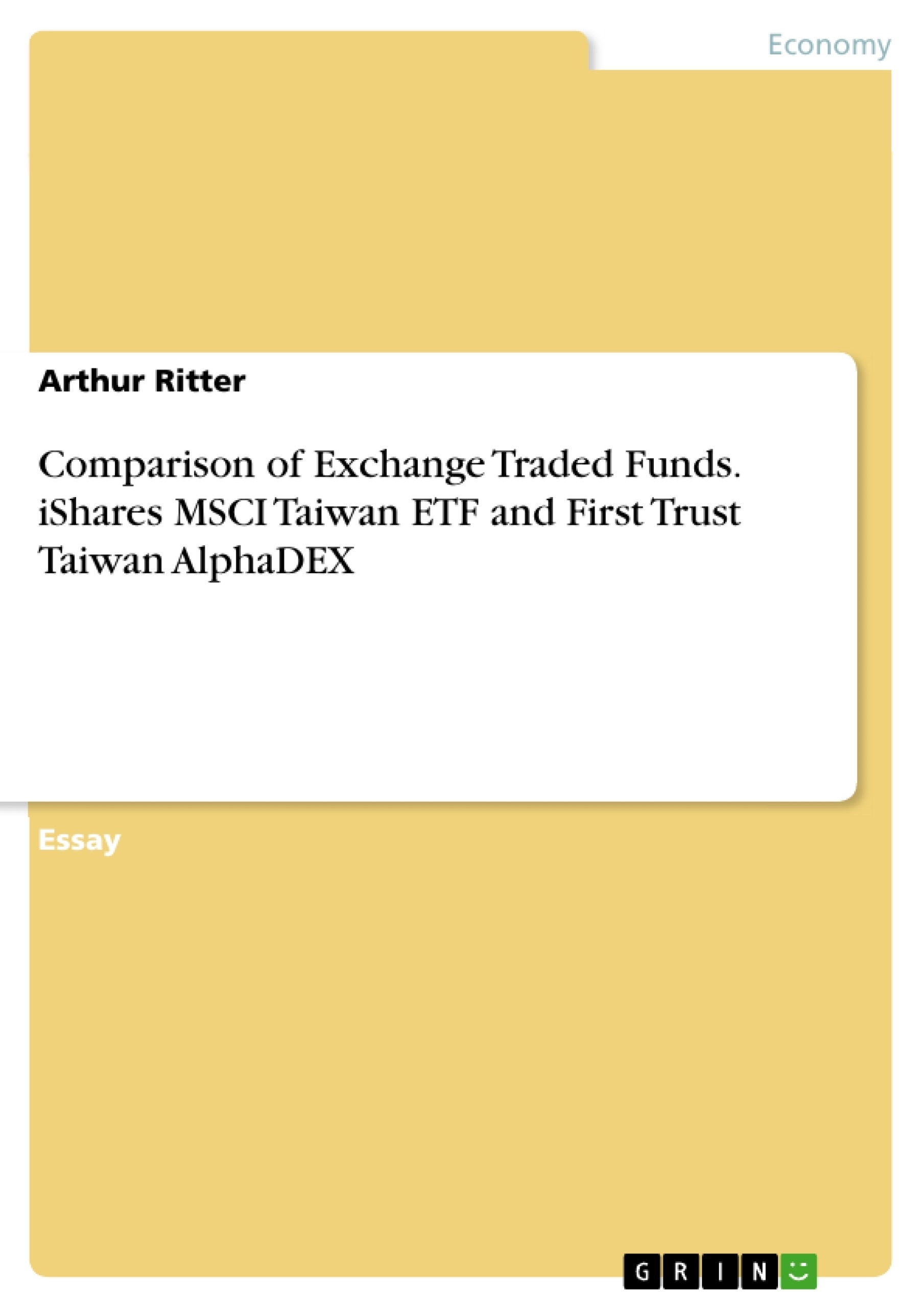ETFs, short for Exchange Traded Funds are traded on the stock market funds. ETFs have no maturity limit and can therefore be permanently traded like shares at the current market price. When buying a fund unit, the investor becomes a shareholder of the components contained in the Funds.
The index can be of a country, an industry, or even a global index. Therefore the investor participates identically in rising and falling markets according to the development of the ETF underlying index.
Unlike actively managed funds Exchange Traded Funds are mainly passively managed. An underlying index should be reproduced as exactly as possible.
ETFs combine the advantages of three asset classes: equities, certificates and funds. Like shares, ETFs can also be traded at the current market value at any time.
This Report compares and contrasts the two Exchange traded funds iShares MSCI Taiwan ETF and First Trust Taiwan AlphaDEX. It will discuss a number of key figures and will stress the strengths and weaknesses of each fund. The following key figures for the two funds are based on self-‐made calculation using Excel and data form Datastream. If any figures are used, which have another source, it will be clearly cited. The time period for all key figures is two years, expect for the Pricing efficiency, which has been calculated for one year. All estimated returns are log returns due to the reason they have the property that they can be interpreted as continuously compounded returns and are addable.
Inhaltsverzeichnis (Table of Contents)
- Introduction
- Overview of the Funds
- Description - iShares MSCI Taiwan ETF
- Description - First Trust Taiwan AlphaDEX
- Risk/Return Profile
- Sharpe Ratio
- Beta
- Standard Deviation
- Tracking Efficiency
- Tracking Error
- Beta and R²
- Pricing Efficiency
Zielsetzung und Themenschwerpunkte (Objectives and Key Themes)
This report aims to compare and contrast the two Exchange traded funds iShares MSCI Taiwan ETF and First Trust Taiwan AlphaDEX. It analyzes various key figures and highlights the strengths and weaknesses of each fund. The report provides a comprehensive evaluation of these ETFs based on their risk/return profile, tracking efficiency, and pricing efficiency.
- Risk/Return Profile: The report examines the risk/return characteristics of both ETFs, including their Sharpe ratios, betas, and standard deviations, to understand their relative risk and potential for returns.
- Tracking Efficiency: The report analyzes the tracking efficiency of the ETFs, including their tracking errors and the relationship between their returns and the underlying index, to evaluate how well they replicate the performance of their respective benchmarks.
- Pricing Efficiency: The report assesses the pricing efficiency of the ETFs, considering the discrepancies between their market prices and their net asset values, to determine their susceptibility to arbitrage opportunities.
- ETF Comparison: The report offers a comparative analysis of the two ETFs, highlighting their similarities and differences in terms of their investment strategies, underlying indices, and key performance metrics.
- Emerging Market Considerations: The report acknowledges the specific risk factors associated with investing in emerging markets, such as higher liquidity risk, restrictions on investment, and potential for political instability.
Zusammenfassung der Kapitel (Chapter Summaries)
The first chapter introduces the concept of Exchange Traded Funds (ETFs) and outlines the scope of the report. It introduces the two ETFs being compared, iShares MSCI Taiwan ETF (EWT) and First Trust Taiwan AlphaDEX (FTW), and outlines the methodology used to analyze them. The second chapter provides a detailed overview of each ETF, describing their investment objectives, underlying indices, and key characteristics. The third chapter analyzes the risk/return profile of the ETFs, examining their Sharpe ratios, betas, and standard deviations. Chapter four focuses on the tracking efficiency of the ETFs, analyzing their tracking errors and the relationship between their returns and the underlying index. The fifth and final chapter explores the pricing efficiency of the ETFs, comparing their market prices with their net asset values and discussing potential arbitrage opportunities.
Schlüsselwörter (Keywords)
Exchange Traded Funds (ETFs), iShares MSCI Taiwan ETF, First Trust Taiwan AlphaDEX, risk/return profile, Sharpe ratio, beta, standard deviation, tracking efficiency, tracking error, pricing efficiency, emerging markets, investment strategies, underlying indices.
- Citar trabajo
- Arthur Ritter (Autor), 2014, Comparison of Exchange Traded Funds. iShares MSCI Taiwan ETF and First Trust Taiwan AlphaDEX, Múnich, GRIN Verlag, https://www.grin.com/document/289141



